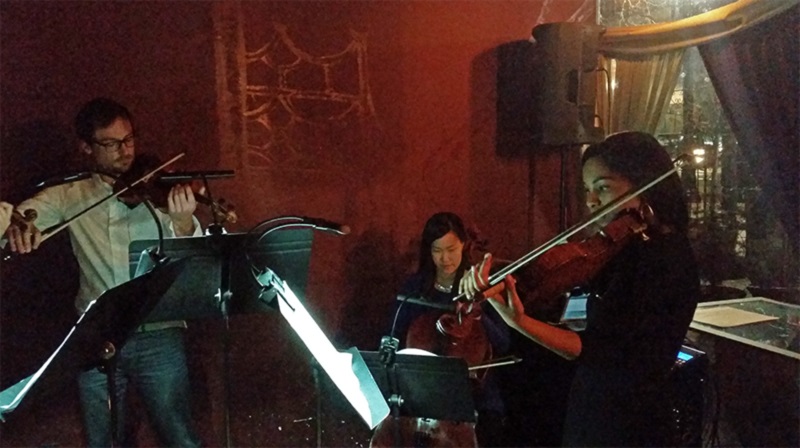MOTUS After Dark @ The Red Door 02.28
Show Reviews
If the show performed by the Musicians Of The Utah Symphony (MOTUS) at The Red Door on Feb. 28 is any indicator of how this group of a dozen or so musicians plan on bringing the music of classical composers closer towards the “mainstream,” then I think they stand a very good chance of realizing their goals. Allow me to explain.
As a music writer, I have a certain bucket list of musicians or artists I would like to see before I die. One of them has always been to see the Orchestra of the Utah Symphony. Yes, them specifically. I figure that by being a resident of Salt Lake City for over 18 years, and them being literally in my backyard, then I should see how the classics are interpreted with some local flavor. There have really only been two reasons I have never gone—the first being that I want to enjoy a show in my own way. This means that if I want to walk around, get a drink and say hello to a friend or whatever, I can do this. At the Symphony, you really aren’t afforded this luxury. Not only that, but although the Utah Symphony does have great rates for single shows, I never seem to have the cash. These reasons, I have found, are also at the top of the list of reasons why a lot of people I know don’t go to the Utah Symphony. This is why I think the concept of what MOTUS is trying to do will not only open many doors to making classical music more accessible, but also make it more modern, as well.
Their model is predicated on a few factors. Make the music selection amazing, make it affordable (the entrance fee was only $4), but also make it engaging and completely interactive. MOTUS has figured out a genius way to incorporate this interactivity in their shows. For example, inbetween songs, master of ceremonies/violinist David Porter would not only tell the name of the upcoming piece about to be played, but would refer the audience to go to their website as well, during the piece. The reason being is that the entire setlist is on the site, along with biographical information about the composer of the piece, and a bit of information about the song itself. This is utter genius. If you can interest an audience in what you are playing (above and beyond just the song itself), then the entire experience and appreciation for the performance will increase vastly.
But all of these bells and whistles don’t mean anything if the performances aren’t solid. This was one area that these musicians had zero problems with. The night I saw them, the revolving cast of musicians were as follows: Leon Chodos (bassoon), Claude Halter (violin), Lun Jiang (violin), Veronica Kulig (violin), Anne Lee (cello), Alexander Martin (violin), Erin Svoboda (clarinet), Whittney Thomas (viola), Titus Underwood (oboe), Karen Wyatt (violin) and Pegson Whang (cello). Their setup would be this: a group of (typically) four would come up to the small corner of the club that had been set up with a small PA system, subdued lighting and music stands with lights, and would be introduced by Porter. He would then give the name of the piece, refer people to the website, and then either join in (if it were a song he played on) or sit down until it was time for the next song. You rarely, if ever, saw the same group of musicians twice. This really lent itself to some amazing interpretations of various pieces by the same composers.
A great example of this was when Martin came up to perform a piece by Ysaÿe, “Danse Rustique,” as a violin solo. It was moving. The tone of the song was very heavily Russian influenced. I would say it would hint around, at times, Brahm’s “Hungarian Dances.” It was played with incredible precision and feel. Within the last few measures of it, there’s a run on the violin that was so well-executed, with such flair, it sent electricity up my spine. Later on in the night, Porter played a different piece by Ysaÿe, “Obsession/Les Furies.” And although the music itself is different as it’s a completely different piece, you could definitely tell that each performer put their own stamp on the music—each would play the accents in their respective pieces with enough differences, that you could tell that each musician held their own, definitive style.
The other highlight of the evening was the performance of Shostakovich’s “String Quartet No. 8, I & II.” played by Wyatt, Halter, Thomas and Lee. It was interesting that this was the selection made as the first song of the second set. You would think each set would begin with a more “famous” selection, something by Mozart, perhaps. But the way it was played set the mood perfectly for the songs that followed—true brilliance.
Porter said that they will be doing another show this spring. He did not say where, but to check out the website above for further details. If you love classical music but hate the thought of being stuck in a chair for three hours, or are afraid you can’t afford a symphony experience, then check out the next MOTUS show, it will change your mind on both counts.


